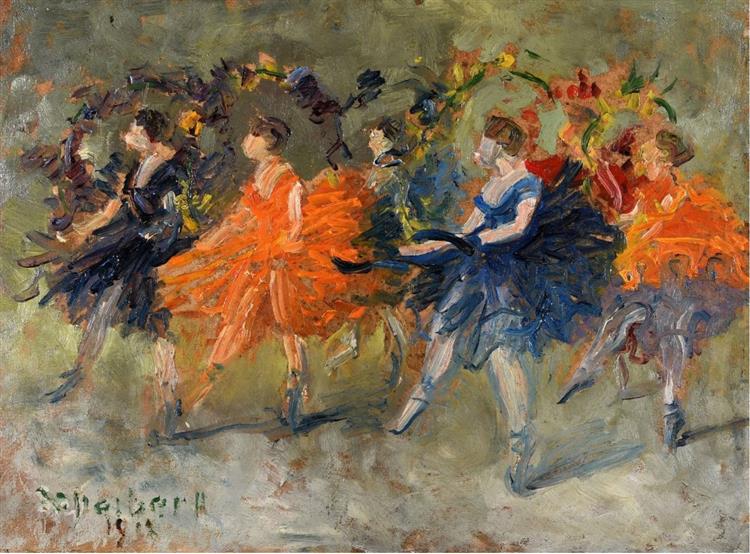Description
The "Balettkar" painting by Hugó Scheiber is revealed as a fascinating visual interpretation of dynamism and the movement inherent in ballet, evoked through the distinctive expressionist style of the Hungarian artist. Scheiber, born in 1873 and died in 1950, is mainly known for its acute ability to capture the energy of modern life and its ability to transform it into a visual amalgam of vibrant color, shape and emotion. This work, in particular, stands out within its production by how it uses the human figure and the space to invoke a particular narrative.
In "Balettkar", the artist presents a composition full of dynamism and elegance. The scene is dominated by stylized dancers, treated with a fusion of curved lines and angles that create a sense of almost palpable movement. The figures are not possessing; They seem to be in the middle of a complex choreography, capturing a fleeting moment of grace and effort. Scheiber uses its characteristic geometric and simplified approach to model silhouettes, which gives the work an abstract but unmistakably human quality.
The use of color in this painting is masterful. The tones of the dancers' dress range between purple, red and pink, contrasting with the tones off the bottom, where the grays and brown predominate. These contrasts not only highlight the figures in space, but also give the scene an additional depth; It seems as if the dancers were emerging towards the viewer from a misty and ethereal space. This technique also allows Scheiber to play with shadows and brightness in a way that further enhances the sense of movement and life in the piece.
In addition, the "Balettkar" spatial composition deserves a more detailed analysis. Scheiber has arranged the figures so that not a single fraction of the canvas feels static or empty. The dancers seem to be turning in a perpetual sway that suggests a circle, or even a spiral, which captures the viewer's gaze and carries it through the paint on a continuous visual trip.
In terms of context, Balettkar is not an aodine or low importance in the cultural and historical field of Eastern Europe during the first half of the twentieth century. In a period of intense social and cultural changes, Scheiber, like other artists of their time, found in the ballet a symbol of sophistication and modernity. This background, added to the inherent tension between the form and movement of the ballet, makes works such as "Balettkar" even more significant and evocative.
Hugó Scheiber, a prominent member of the Kutala movement, demonstrated throughout his career a fascination with urban issues and portraits of modern life, which aligned him with the concerns and aesthetics of European expressionists and futuristic. The "Balettkar" painting is no exception to this trend. On the contrary, it is firmly within this artistic tradition that seeks to capture the accelerated contemporary life and the deepest human emotions through a prism of color and line.
In short, "Balettkar" by Hugó Scheiber is a work that not only represents the art of ballet, but also encapsulates it with such vitality and dynamics that invites a prolonged and continued contemplation. It is a celebration of the human form at its expression, a testimony of Scheiber's talent to transform the everyday into something extraordinary.
KUADROS ©, a famous paint on your wall.
Hand-made oil painting reproductions, with the quality of professional artists and the distinctive seal of KUADROS ©.
Art reproduction service with satisfaction guarantee. If you are not completely satisfied with the replica of your painting, we refund your money 100%.

